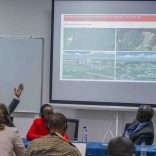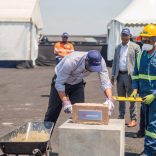Mozambique: RUSI and Embassy of the Kingdom of Norway in Maputo present OCTA project findings
Mozambique: Water unfit for human consumption in the Zambezi and Incomáti Basins – A Verdade

The National Directorate of Water Resources Management (DNGRH) has recognised the existence of water unfit for human consumption in the Zambezi and Incomáti Basins.
“Levels above established standards were observed in the south of the country, specifically in the PZ02 in Montanhane,” the 1st Groundwater Monitoring Bulletin points out, also indicating “levels above the required parameters in MT07 in Matema”.
The first 2020 study on the quality of groundwater, a source of supply for about 67 percent of the population through 19,280 boreholes across the country, observed nitrate levels in the southern region “above the established parameters, specifically in the PZ02 in Montanhane, probably due to the deficient sanitation systems (misuse of latrine) and, comparing [levels] to [those of] the previous semester, there was a significant increase since this parameter was within the established parameters”.
“In the central region, levels above the required parameters were recorded in MT07 in Matema, a fact that must be related to open defecation and animal excrement, as well as the practice of agriculture based on fertilisers,” the study published by the DNGRH last week indicates.
Although unable to take samples because of the impact of Cyclone Kenneth on equipment, reports from the north show, in principle, levels of nitrates “within the allowable limits for human consumption”.
Chloride levels above the permissible limits were recorded in PZ02 in Montanhane, P08 in Macanzene, PZ10 in Matilde, PZ14 in Gumbana, PZ16 in Matola -Estrada Velha, PZ17 in Nhavambe. This factor can serve as an indication of contamination of boreholes by sea water (saline intrusion), since these piezometers are located in areas close to the coastal strip.
In the central region, chloride values are within the allowable limits for human consumption, the study, to which @Verdade has enjoy access, reports.
“Water quality has worsened due to anthropogenic activities”
Regarding pH (acidity/alkalinity), the DNGRH document observes that, in the south, “there were no levels above the recommended values for human consumption, although it was observed that the PZ01 in Cumbeza, PZ02 in Montanhane and PZ38 in Ponta Malengane are below the values recommended by the Ministry of Health in relation to the other piezometers. This may be associated with the low precipitation recorded in these places, which, in a way, conditions low alkalinity, one of the factors on which pH depends”.
With regard to pH in the central and northern regions, the values are “within the allowable limits for human consumption”.
An analysis of electrical conductivity [EC] registered, in the south, high levels “in PZ14 in Gumbana, PZ16 in Matola-Estrada Velha, PZ17 in Nhavambe, probably due to regional hydrogeological conditions or even excessive water abstraction, since excessive pumping in an aquifer may result in an interface movement, causing an increase in salts within this same aquifer (saline intrusion).
“In the case of the Central and North regions, as with the pH variation, EC values are within the allowable limits for human consumption.”
In Mozambique, exploitable groundwater is estimated at 61,000 million cubic metres per year and, in general, the National Directorate of Water Resources Management considers that the “water quality in most basins is moderate, but in some basins, such as the Zambeze, Púngoè and Búzi, water quality has worsened due to anthropogenic activities”, that is, from human activity such as poor sanitation and agriculture practices.
By Adérito Caldeira












Leave a Reply
Be the First to Comment!
You must be logged in to post a comment.
You must be logged in to post a comment.